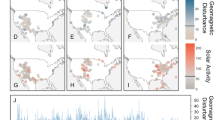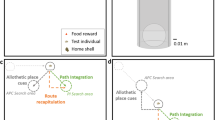Abstract
THE orientation of birds on migratory and homing flights stillposes such baffling problems that the publication of an entirely new theory is a matter of exceptional importance to ornithologists. Critical experimental work on the homing of wild birds under conditions such that all guidance by-previous knowledge of topography is ruled out, is still all too sparse. Nevertheless, evidence has for a long time been slowly accumulating that some species at any rate must possess powers of orientation independent of any terrestrial landmarks (see Griffin, 1944; review1); and more recently Rüppell2 has added a further substantial piece of evidence for some ‘sense of direction’. But what sensory mechanism could enable the bird to estimate correctly experimental displacement and maintain direction ? For clearly any sensory equipment which is to meet fully the needs of the homing or migrating bird under adverse conditions, as when familiar landmarks are absent or obscured, must at least provide information with regard both to direction and latitude.
This is a preview of subscription content, access via your institution
Access options
Subscribe to this journal
Receive 51 print issues and online access
$199.00 per year
only $3.90 per issue
Buy this article
- Purchase on Springer Link
- Instant access to full article PDF
Prices may be subject to local taxes which are calculated during checkout
Similar content being viewed by others
References
Griffin, D. R., Quart. Rev. Biol., 19, 15 (1944).
Rüppell, J. Orn. Lpz., 92, 106 (1944); see Ibis, 88, 262 (1944).
Ising, G., Ark. Matematik, Astronomi och Fysik, 32A, N. 18, 1 (1945).
Lowenstein, O., and Sand, A., Proc. Roy. Soc., B, 129, 256 (1940).
Retzius, "Das Gehörorgan der Wirbelthiere", 2 ( Stockholm, 1885).
Heinroth, O., J. Orn. Lpz., 70, 172 (1922).
Witherby, H. F., et al., "Handbook of British Birds" (1938–42).
Author information
Authors and Affiliations
Rights and permissions
About this article
Cite this article
THORPE, W., WILKINSON, D. Ising's Theory of Bird Orientation. Nature 158, 903–904 (1946). https://doi.org/10.1038/158903a0
Issue Date:
DOI: https://doi.org/10.1038/158903a0
This article is cited by
-
Aus der Geschichte der Orientierungsforschung
Journal für Ornithologie (1989)
-
Orientation of Birds on Migratory and Homing Flights
Nature (1948)
-
Die Reizschwelle der Sinnesorgane als physikalisches Problem
Experientia (1948)
Comments
By submitting a comment you agree to abide by our Terms and Community Guidelines. If you find something abusive or that does not comply with our terms or guidelines please flag it as inappropriate.



